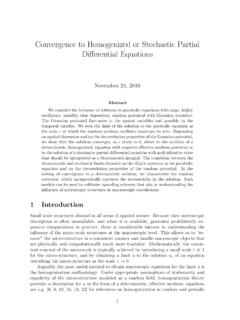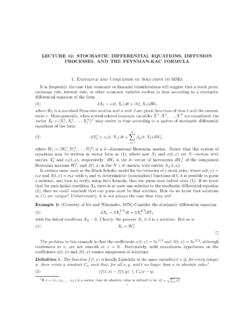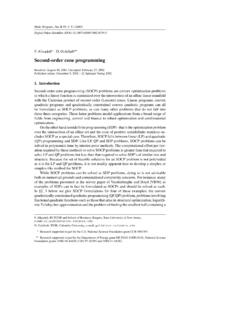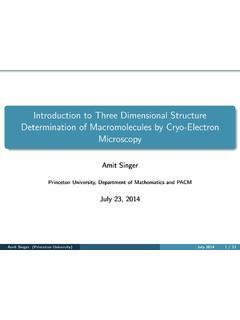Transcription of LECTURE 12: STOCHASTIC DIFFERENTIAL EQUATIONS, …
1 LECTURE 12: STOCHASTIC DIFFERENTIAL equations , DIFFUSION. PROCESSES, AND THE FEYNMAN-KAC FORMULA. 1. Existence and Uniqueness of Solutions to SDEs It is frequently the case that economic or financial considerations will suggest that a stock price, exchange rate, interest rate, or other economic variable evolves in time according to a STOCHASTIC DIFFERENTIAL equation of the form (1) dXt = (t, Xt ) dt + (t, Xt ) dWt where Wt is a standard Brownian motion and and are given functions of time t and the current state x. More generally, when several related economic variables X 1 , X 2 , .. , X N are considered, the vector Xt = (Xt1 , Xt2 , .. , XtN )T may evolve in time according to a system of STOCHASTIC DIFFERENTIAL equations of the form d ij (t, Xt ) dWtj , X. (2) dXti = i (t, Xt ) dt +. j=1. where Wt = (Wt1 , Wt2 , .. , Wtd ) is a d dimensional Brownian motion. Notice that this system of equations may be written in vector form as (1), where now X t and (t, x) are N vectors with entries Xti and i (t, x), respectively; dWt is the d vector of increments dWtj of the component Brownian motions Wtj ; and (t, x) is the N d matrix with entries ij (t, x).
2 In certain cases, such as the Black-Scholes model for the behavior of a stock price, where (t, x) =. rt x and (t, x) = t x with rt and t deterministic (nonrandom) functions of t, it is possible to guess a solution, and then to verify, using Ito 's formula, that the guess does indeed obey (1). If we knew that for each initial condition X0 there is at most one solution to the STOCHASTIC DIFFERENTIAL equation (1), then we could conclude that our guess must be that solution. How do we know that solutions to (1) are unique? Unfortunately, it is not always the case that they are! Example 1: (Courtesy of Ito and Watanabe, 1978) Consider the STOCHASTIC DIFFERENTIAL equation 1/3 2/3. (3) dXt = 3Xt dt + 3Xt dWt with the initial condition X0 = 0. Clearly, the process Xt 0 is a solution. But so is (4) Xt = Wt3 .. The problem in this example is that the coefficients (t, x) = 3x 1/3 and (t, x) = 3x2/3 , although continuous in x, are not smooth at x = 0. Fortunately, mild smoothness hypotheses on the coefficients (t, x) and (t, x) ensure uniqueness of solutions.
3 Definition 1. The function f (t, x) is locally Lipschitz in the space variable(s) x if, for every integer n, there exists a constant Cn such that, for all x, y, and t no larger than n in absolute value 1, (5) |f (t, x) f (t, y)| Cn |x y|. 1If x = (x , x , .. , x ) is a vector, then its absolute value is defined to be |x| =. pP. 1 2 n i x2i . 1. In practice, one rarely needs to verify this condition, because the following is true, by the mean value theorem of calculus: If f (t, x) is continuously differentiable, then it locally Lipschitz. Occasionally one encounters situations where one of the coefficients in a STOCHASTIC DIFFERENTIAL equation has corners (for instance, the function f (x) = |x|); such functions are locally Lipschitz but not continuously differentiable. Theorem 1. Suppose that the functions i (t, x) and ij (t, x) are all locally Lipschitz in the space variable x. Then for each initial condition X 0 = x0 , there is at most one solution to the system of STOCHASTIC DIFFERENTIAL equations (2).
4 Are there always solutions to STOCHASTIC DIFFERENTIAL equations of the form (1)? No! In fact, existence of solutions for all time t 0 is not guaranteed even for ordinary DIFFERENTIAL equations (that is, DIFFERENTIAL equations with no random terms). It is important to understand why this is so. A DIFFERENTIAL equation (or a system of DIFFERENTIAL equations ) prescribes how the state vector Xt will evolve in any small time interval dt, for as long as the state vector remains finite. However, there is no reason why the state vector must remain finite for all times t 0. Example 2: Consider the ordinary DIFFERENTIAL equation dx 1. (6) = for 0 t < 1. dt 1 t The solution for the initial condition x 0 is Z t (7) x(t) = x0 + (1 s) 1 ds = x0 log(1 t) for 0 t < 1. 0. As t approaches 1, x(t) converges to .. Example 3: The previous example shows that if the coefficients in a DIFFERENTIAL equation depend explicitly on t then solutions may explode in finite time. This example shows that explosion of solutions may occur even if the DIFFERENTIAL equation is autonomous, that is, if the coefficients have no explicit time dependence.
5 The DIFFERENTIAL equation is dx (8) = x2 . dt The general solution is (9) x(t) = (t C) 1 . For the initial condition x(0) = x0 > 0, the value of C must be C = 1/x0 . Consequently, the solution x(t) explodes as t approaches 1/x 0 .. Observe that in Example 2, the coefficient (t, x) = x 2 is not only time-independent, but con- tinuously differentiable, and therefore locally Lipschitz. Hence, the hypotheses of Theorem 1 do not guarantee existence of solutions for all t. The next theorem gives useful sufficient conditions for the existence of solutions for all t. Theorem 2. Assume that the coefficients in the system (1) of STOCHASTIC DIFFERENTIAL equations satisfy the following global Lipschitz and growth conditions: for some C < , (10) | i (t, x) i (t, y)| C|x y| for all t R and x, y R N. | ij (t, x) ij (t, y)| C|x y| for all t R and x, y R N. | i (t, x)| C|x| for all t R and x RN , and | ij (t, x)| C|x| for all t R and x RN . Then for each x0 RN there is a (unique) solution to the system (1) such that X 0 = x0.
6 The existence and uniqueness theorems 1 and 2 stated above were proved by Ito in 1951. The proofs follow the lines of the classical proofs for existence and uniqueness of solutions of ordinary DIFFERENTIAL equations , with appropriate modifications for the random terms. See, for instance, Karatzas & Shreve for details. More properties of the Ornstein-Uhlenbeck process are given in the exercises. 2. The Ornstein-Uhlenbeck Process In the parlance of professional probability, a diffusion process is a continuous-time STOCHASTIC process that satisfies an autonomous (meaning that the coefficients and do not depend explicitly on the time variable t) STOCHASTIC DIFFERENTIAL equation of the form (1). Such processes are necessarily (strong) Markov Apart from Brownian motion, perhaps the most important diffusion process is the Ornstein-Uhlenbeck process, known also in finance circles as the Vasicek model. The Ornstein-Uhlenbeck process is the prototypical mean-reverting process: although random, the process exhibits a pronounced tendency toward an equilibrium value, just as an oscillating pendulum or spring is always pulled toward its rest position.
7 In financial applications, the Ornstein-Uhlenbeck process is often used to model quantities that tend to fluctuate about equilibrium values, such as interest rates or volatilities of stock prices. The STOCHASTIC DIFFERENTIAL equation for the Ornstein- Uhlenbeck process is (11) dYt = (Yt ) dt + dWt , where , R and > 0 are parameters. Observe that, if = 0 then this becomes an ordinary DIFFERENTIAL equation with an attractive rest point at . (Exercise: Find the general solution when = 0, and verify that as t every solution curve converges to .) The term dW t allows for the possibility of random fluctuations about the rest position ; however, if Y t begins to randomly wander very far from then the mean-reversion term (Y t ) dt becomes larger, forcing Yt back toward . The coefficients of the STOCHASTIC DIFFERENTIAL equation (11) satisfy the hypotheses of Theorem 2, and so for every possible initial state y 0 R there is a unique solution Yt . In fact, it is possible to give an explicit representation of the solution.
8 Let's try the simplest case, where = 0. To guess such a representation, try a combination of ordinary and STOCHASTIC (Ito ) integrals; more generally, try a combination of nonrandom functions and Ito integrals: Z t . Yt = A(t) y0 + B(s) dWs , 0. 2A thorough discussion of such issues is given in the XXX-rated book Multidimensional Diffusion Processes be Stroock and Varadhan. For a friendlier introduction, try Steele's new book STOCHASTIC Calculus with Financial Applications. where A(0) = 1. If A(t) is differentiable and B(t) is continuous, then Z t . 0. dYt = A (t) y0 + B(s) dWs dt + A(t)B(t) dWt 0. A0 (t). = Yt dt + A(t)B(t) dWt . A(t). Matching coefficients with (11) shows that A 0 (t)/A(t) = and A(t)B(t) = . Since A(0) = 1, this implies that A(t) = exp { t} and B(t) = exp { t}. Thus, for any initial condition Y 0 = y0 , the solution of (11) is given by Z t (12) Yt = exp { t} y0 + exp { t} exp { s} dWs 0. The explicit formula (12) allows us to read off a large amount of important information about the Ornstein-Uhlenbeck process.
9 First, recall that it is always the case that the integral of a nonrandom function f (s) against dWs is a normal (Gaussian) random variable, with mean zero and variance 2. R. f (s) ds. Thus, for each t, 2 t . t 21 e (13) Yt Normal y0 e , . 2 . As t , the mean and variance converge (rapidly!) to 0 and 2 /2 , respectively, and so 2.. D. (14) Yt Normal 0, . 2 . This shows that the Ornstein-Uhlenbeck process has a stationary (or equilibrium, or steady-state). distribution, and that it is the Gaussian distribution with the paramaters shown above. In fact, formula (12) implies even more. Consider two different initial states y 0 and y00 , and let Yt and Yt0 be the solutions (12) to the STOCHASTIC DIFFERENTIAL equation (11) with these initial conditions, respectively. Then (15) Yt Yt0 = exp { t} (y0 y00 ). Thus, the difference between the two solutions Y t and Yt0 decays exponentially in time, at rate . For this reason is sometimes called the relaxation parameter. 3.
10 Diffusion equations and the Feynman-Kac Formula Diffusion processes (specifically, Brownian motion) originated in physics as mathematical models of the motions of individual molecules undergoing random collisions with other molecules in a gas or fluid. Long before the mathematical foundations of the subject were laid 3, Albert Einstein realized that the microscopic random motion of molecules was ultimately responsible for the macroscopic physical phenomenon of diffusion, and made the connection between the volatility parameter . of the random process and the diffusion constant in the partial DIFFERENTIAL equation governing The connection between the DIFFERENTIAL equations of diffusion and heat flow and the 3around 1920, by Norbert Wiener, who proved that there is a probability distribution (measure) P on the space of continuous paths such that, if one chooses a path Bt at random from this distribution then the resulting STOCHASTIC process is a Brownian motion, as defined in LECTURE 5.





